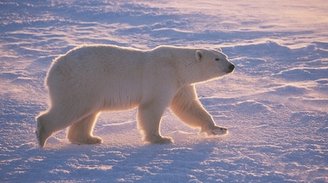
气候变化下狂奔的北极熊
Climate Change Fires Up Polar Bear Treadmill
气候变化下狂奔的北极熊
Sea ice is drifting faster in the Arctic—which means polar bears need to walk farther to stay in their native range.
北极的海上冰层正加速漂移,这意味着北极熊不得不向更远的地方迁移,以确保能够待在自己原本的领地内。
撰文/波音 艾米莉·施温 (Emily Schwing)
翻译 潘磊
审校 郭晓
Polar Bears spend most of their time roaming the sea ice in search of seals. And seals spend most of their time underneath that ice, avoiding the top predator. But climate change is giving polar bears additional challenges in their searches for food.
北极熊们会花大部分时间在冰面徘徊,猎捕海豹。而海豹大部分时间则躲在冰面下,避免和头号捕食者碰面。但是,气候变化使北极熊在捕食上面临更大的挑战。
“Sea ice is now drifting faster.” George Durner is a research zoologist with the United States Geological Survey Polar Bear Research Program. He and colleagues compared sea ice conditions from 1987–1998 with those from 1999 to 2013.
“冰层正在加速漂移。” 美国地质调查局北极熊研究项目的研究动物学家乔治·杜尔纳(George Durner)如是说。他和同事比较了1987到1998年间和1999到2013年间的冰层情况,得出了这个结论。
“And what we found was ice drift at the locations used by polar bears increased 30% in the Beaufort sea and 37% in the Chukchi sea.” That’s a problem because polar bears are homebodies—they prefer to stay in a specific range.
“我们发现在波弗特海(Beaufort sea)和楚克其海(Chukchi sea),北极熊栖息区域的冰层漂移分别增加了30%和37%。”这是个问题,因为北极熊是极其“恋家”的动物——它们更愿意待在特定的范围内。
“Throughout their range, they seem to have a sense of place. And…here we have a situation where the general pattern of ice drift is westward, so to remain in your traditional range, it means you have to constantly be walking eastward to compensate for that westward drift.”
“在北极熊的地盘上,它们似乎有领地意识。在这里我们面临的情况是:海冰总体向西飘移,所以如果要保持在原来的范围内,就意味着你必须不断向东行走,以补偿向西漂移的部分。
The result: a large-scale polar bear treadmill. And all that walking requires extra fuel. On average, a single bear eats between 31 and 33 seals per year. But the metabolic consequence of the treadmill effect means they have to eat on average one to three more. The study is in the journal Global Change Biology. [George M. Durner et al., Increased Arctic sea ice drift alters adult female polar bear movements and energetics]
结果就是:冰面变成了一个大型的北极熊跑步机。而所有这些运动都需要额外的能量。一只熊每年平均捕食31—33只海豹。但“跑步机效应“的代谢后果意味着它们每年平均要多捕食1-3只海豹。该研究发表在《全球变化生物学》(Global Change Biology)杂志上。
And not only is the ice drifting faster—it’s also melting more, giving the bears less of the platform they use to pursue their prey. So they need more seals but have a tougher time tracking them. All of which puts polar bears on a slippery slope.
冰块不仅漂移得更快,而且融化得也更多,这使得北极熊捕食猎物的阵地越来越少。所以它们需要更多的海豹,但捕猎却变得更加艰难。所有这些都使北极熊的生存状态急剧下滑。
未经书面许可任何人不得复制或镜像
京ICP备11000850号-1
 京公网安备11010502039775号
京公网安备11010502039775号 信息网络传播视听节目许可证0111611号
国家科技基础条件平台

















